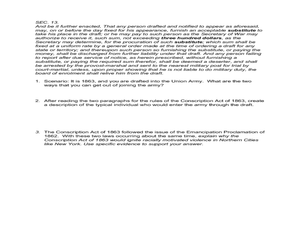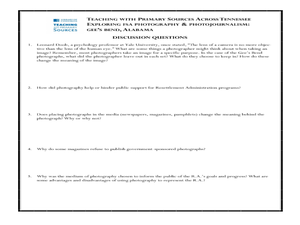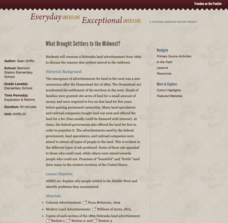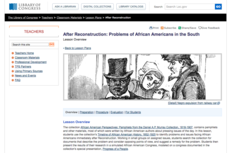Stanford University
Prohibition
Prohibition banned the selling of alcohol in America—but why? Designed for high school pupils, the lesson explores the causes of Prohibition including the Temperance Movement. The lesson pairs a PowerPoint presentation with worksheets...
Curated OER
The Conestoga Wagon
Learners research the Conestoga wagon. In this early transportation lesson, students use primary documents to research how the invention of the Conestoga wagon improved transportation.
Curated OER
Declaration of Independence
Eleventh graders interpret and analyze political cartoons. In this primary source analysis lesson, 11th graders examine the implications of Industrialization as they respond to questions regarding selected political cartoons about the...
Curated OER
What Really Caused This?
In this primary source analysis worksheet, high schoolers read a copy of the Conscription Act of 1863 and respond to 7 short answer questions about its content. The text of the act is not included.
Curated OER
Drake’s West Indian Voyage 1588-1589
Students examine the exploration routes of Sir Francis Drake. In this American exploration lesson, students investigate primary sources to trace the routes and contact with the natives that Sir Francis Drake experienced on his voyages in...
Curated OER
A Visit to Aunt Louisa's
Fourth graders write a diary entry. In this journaling instructional activity students examine a 1880's primary source document. Students read about a young girl visiting her Aunt in rural Indiana. Students write about what they did in...
Curated OER
Southeastern Native Americans' Lifestyles
Young scholars complete activities to learn about Southeastern Native Americans. In this lifestyles lesson, students watch a PowerPoint about Southeastern Native Americans, view artifacts from the region and discuss the objects with a...
Curated OER
Why War? Causes of the American Revolution and South Carolina's Role
Eighth graders investigate the role of South Carolina in the American Revolution. In this colonial American lesson, 8th graders analyze primary documents and images to determine how the state was involved in the outbreak of the war and...
Curated OER
Thomas Jefferson's Library: Making the Case for a National Library
Students examine the need for a national library. In this Library of Congress lesson plan, students analyze primary sources to investigate the persuasive techniques that Thomas Jefferson used in a letter meant to show his support of the...
Curated OER
South Carolina: Loyalist or Patriot?
Eighth graders examine the battle waged in South Carolina over the American Revolution. In this American Revolution lesson, 8th graders analyze primary sources as they determine how the Loyalists and Patriots chose sides in the war.
Curated OER
Teaching with Primary Sources Across Tennessee
Students examine Gee's Bend Alabama. In this resettlement lesson, students view a series of photographs taken of Gee's Bend Alabama. Students will write a series of newspaper articles based on the images, that exemplify the evolution of...
Curated OER
Picturing Freedom: Selma-to-Montgomery March, 1965
Students analyze primary sources to investigate the Civil Rights Movement. In this Civil Rights lesson plan, students explore the passage of Voting Rights Act of 1965 and how photojournalism impacted the passage of the legislation....
Curated OER
Immigration and Migration: Today and During the Great Depression
Students conduct interviews, analyze primary sources including docuements and images to gain an inderstanding of the causes and effects of he Great Depression and immigration.
Curated OER
Technologies of the Civil War
Fifth graders discover new and interesting technologies of the Civil War. In this Civil War portfolio of lessons, 5th graders analyze primary resources, develop new vocabulary, investigate websites, and create a time line of new...
Curated OER
What Kind of Santa Claus You Are.
Students use a photograph analysis sheet to analyze primary sources (photographs) of the Great Depression in small groups. They then write a poem about kids in the Depression Era that reflects their comprehension of the period and its...
Curated OER
How Has African American Culture Shaped the History of Kentucky?
Eleventh graders explore the African American culture and history of Kentucky. They observe how an author's personal bias can define the argument of his/her publication. Students analyze primary source documents.
Curated OER
The Home Front (Circa 1863)
Students interpret historical evidence presented in primary and secondary resources. In this American Civil War lesson, students examine sources and then write personal accounts of the war.
Roy Rosenzweig Center for History and New Media
What Brought Settlers to the Midwest?
Drawn by promises of fertile land, thousands of settlers poured West because of the Homestead Act of 1862. By examining images of the ads that drew them westward, learners consider the motivations for movement. They also consider how the...
Curated OER
First Nations: Analysing Sources
Ninth graders examine the lifestyle and culture of First Nations people. They investigate and analyze primary and secondary source documents.
Library of Congress
After Reconstruction: Problems of African Americans in the South
Lynchings, race riots, and Jim Crow laws were just a few examples of antagonism that African Americans faced after Emancipation. Class groups investigate these and other events, and prepare a presentation to inform the class about the...
Gilder Lehrman Institute of American History
Slave Narratives: Frederick Douglass, Harriet Jacobs, and the Columbian Orator
Young historians practice in-depth, quality analysis of primary source texts in this three-lesson unit, which examines excerpts from the slave narratives of Frederick Douglass, Harriet Jacobs, and Caleb Bingham.
National Endowment for the Humanities
The "To Do List" of the Continental Congress
What is on your to-do list today? The second lesson plan of a three-part series on Lost Heroes of America investigates the laundry list of items in front of the second Continental Congress. Scholars research, analyze, and present...
Curated OER
Not Getting the News about the Stamp Act
How did American colonists react to the Stamp Act of 1765? Your young historians will examine primary source material by reading excerpts from a transcription of the Pennsylvania Gazette and then identifying the sentiments expressed by...
Curated OER
The Embodied Presidency
Tenth graders compare and contrast the immigration reform policies of Presidents Reagan and Bush. In this immigration lesson, 10th graders examine primary documents related to each president's policy for immigration reform. Students...

























